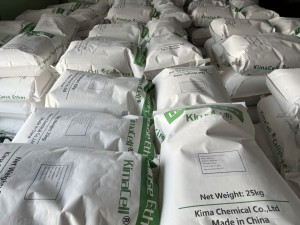Cellulose gum, also known as carboxymethylcellulose (CMC), is a water-soluble polymer derived from cellulose, a natural polymer that forms the primary structural component of plant cell walls. Cellulose gum is widely used in the food, pharmaceutical, and personal care industries as a thickener, stabilizer, and binder due to its unique properties.
Cellulose gum is produced by chemically modifying cellulose through a reaction with sodium hydroxide and monochloroacetic acid. The resulting product is a sodium salt of carboxymethylcellulose, which is a water-soluble, anionic polymer that can form a gel-like structure when hydrated.
One of the primary uses of cellulose gum is as a thickener in food products. It can be used in a variety of food applications, including sauces, dressings, baked goods, and ice cream. In these applications, cellulose gum functions as a thickening agent by increasing the viscosity of the product, improving texture, and preventing separation of ingredients. Cellulose gum is often used in conjunction with other thickeners, such as xanthan gum or guar gum, to achieve thedesired texture and stability.
Cellulose gum is also commonly used as a stabilizer in food products. It can prevent the formation of ice crystals in frozen foods, prevent separation of ingredients in emulsions, and prevent sedimentation in beverages. In addition, cellulose gum can be used as a binder in meat products, such as sausages and meatloaf, to improve texture and reduce fat content.
In the pharmaceutical industry, cellulose gum is used as a binder in tablet formulations to hold the active ingredients together and improve the compressibility of the powder. Cellulose gum is also used as a disintegrant in tablets and capsules to aid in the breakdown of the tablet or capsule in the digestive system.
In the personal care industry, cellulose gum is used as a thickener and stabilizer in a variety of products, including shampoos, conditioners, and lotions. It can also be used as a film-forming agent in hairsprays and other styling products.
One of the advantages of cellulose gum is that it is non-toxic and non-allergenic, making it safe for use in a wide range of applications. In addition, cellulose gum is stable over a wide pH range and is not affected by heat or freezing, making it suitable for use in a variety of processing conditions.
Cellulose gum is also an environmentally friendly ingredient. It is derived from a renewable resource, and the production process is relatively energy-efficient. Cellulose gum is also biodegradable and can be broken down by natural processes in the environment.
Despite its many benefits, there are some limitations to the use of cellulose gum. One of the primary limitations is that it can be difficult to disperse in water, which can lead to clumping and inconsistent performance. In addition, cellulose gum can have a negative impact on the flavor and mouthfeel of certain food products, particularly in high concentrations.

Post time: Feb-27-2023
